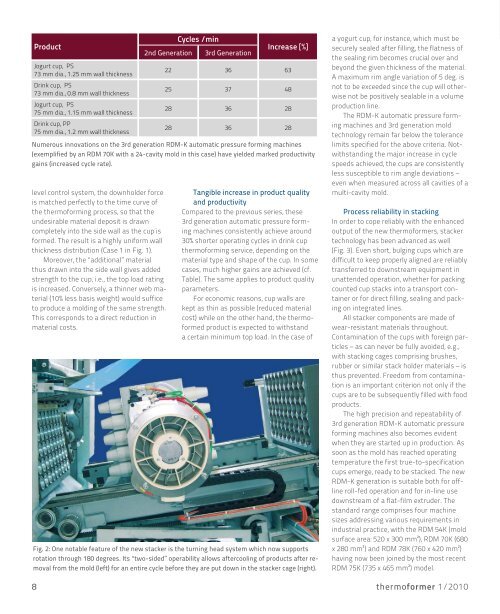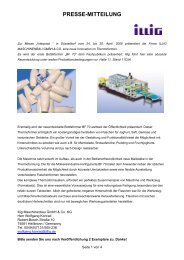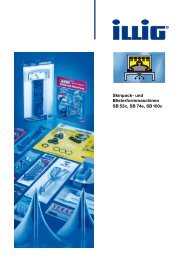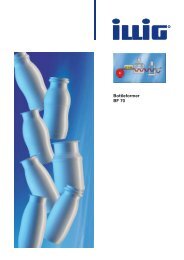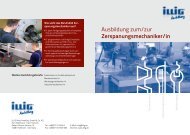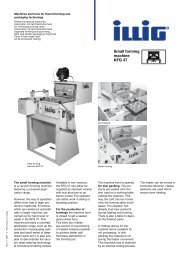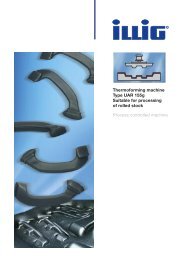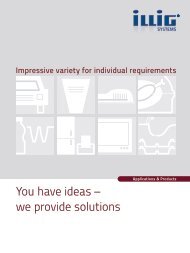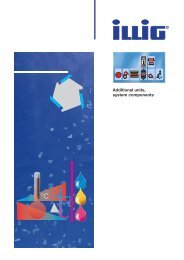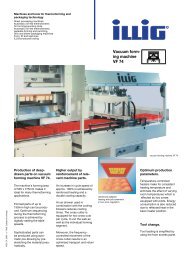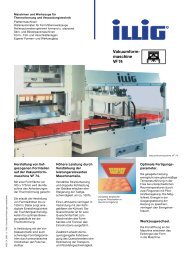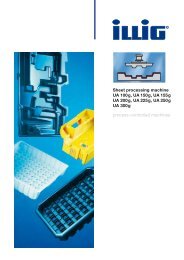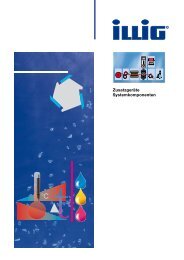Thermoforming - ILLIG Maschinenbau GmbH & Co. KG
Thermoforming - ILLIG Maschinenbau GmbH & Co. KG
Thermoforming - ILLIG Maschinenbau GmbH & Co. KG
Create successful ePaper yourself
Turn your PDF publications into a flip-book with our unique Google optimized e-Paper software.
Product<br />
Jogurt cup, PS<br />
73 mm dia., 1.25 mm wall thickness<br />
Drink cup, PS<br />
73 mm dia., 0.8 mm wall thickness<br />
Jogurt cup, PS<br />
75 mm dia., 1.15 mm wall thickness<br />
Drink cup, PP<br />
75 mm dia., 1.2 mm wall thickness<br />
2nd Generation<br />
level control system, the downholder force<br />
is matched perfectly to the time curve of<br />
the thermoforming process, so that the<br />
undesirable material deposit is drawn<br />
completely into the side wall as the cup is<br />
formed. The result is a highly uniform wall<br />
thickness distribution (Case 1 in Fig. 1).<br />
Moreover, the “additional” material<br />
thus drawn into the side wall gives added<br />
strength to the cup, i.e., the top load rating<br />
is increased. <strong>Co</strong>nversely, a thinner web material<br />
(10% less basis weight) would suffice<br />
to produce a molding of the same strength.<br />
This corresponds to a direct reduction in<br />
material costs.<br />
Cycles /min<br />
3rd Generation<br />
Increase [%]<br />
22 36 63<br />
25 37 48<br />
28 36 28<br />
28 36 28<br />
Numerous innovations on the 3rd generation RDM-K automatic pressure forming machines<br />
(exemplified by an RDM 70K with a 24-cavity mold in this case) have yielded marked productivity<br />
gains (increased cycle rate).<br />
Tangible increase in product quality<br />
and productivity<br />
<strong>Co</strong>mpared to the previous series, these<br />
3rd generation automatic pressure forming<br />
machines consistently achieve around<br />
30% shorter operating cycles in drink cup<br />
thermoforming service, depending on the<br />
material type and shape of the cup. In some<br />
cases, much higher gains are achieved (cf.<br />
Table). The same applies to product quality<br />
parameters.<br />
For economic reasons, cup walls are<br />
kept as thin as possible (reduced material<br />
cost) while on the other hand, the thermoformed<br />
product is expected to withstand<br />
a certain minimum top load. In the case of<br />
Fig. 2: One notable feature of the new stacker is the turning head system which now supports<br />
rotation through 180 degrees. Its “two-sided” operability allows aftercooling of products after removal<br />
from the mold (left) for an entire cycle before they are put down in the stacker cage (right).<br />
a yogurt cup, for instance, which must be<br />
securely sealed after filling, the flatness of<br />
the sealing rim becomes crucial over and<br />
beyond the given thickness of the material.<br />
A maximum rim angle variation of 5 deg. is<br />
not to be exceeded since the cup will otherwise<br />
not be positively sealable in a volume<br />
production line.<br />
The RDM-K automatic pressure forming<br />
machines and 3rd generation mold<br />
technology remain far below the tolerance<br />
limits specified for the above criteria. Notwithstanding<br />
the major increase in cycle<br />
speeds achieved, the cups are consistently<br />
less susceptible to rim angle deviations –<br />
even when measured across all cavities of a<br />
multi-cavity mold.<br />
Process reliability in stacking<br />
In order to cope reliably with the enhanced<br />
output of the new thermoformers, stacker<br />
technology has been advanced as well<br />
(Fig. 3). Even short, bulging cups which are<br />
difficult to keep properly aligned are reliably<br />
transferred to downstream equipment in<br />
unattended operation, whether for packing<br />
counted cup stacks into a transport container<br />
or for direct filling, sealing and packing<br />
on integrated lines.<br />
All stacker components are made of<br />
wear-resistant materials throughout.<br />
<strong>Co</strong>ntamination of the cups with foreign particles<br />
– as can never be fully avoided, e.g.,<br />
with stacking cages comprising brushes,<br />
rubber or similar stack holder materials – is<br />
thus prevented. Freedom from contamination<br />
is an important criterion not only if the<br />
cups are to be subsequently filled with food<br />
products.<br />
The high precision and repeatability of<br />
3rd generation RDM-K automatic pressure<br />
forming machines also becomes evident<br />
when they are started up in production. As<br />
soon as the mold has reached operating<br />
temperature the first true-to-specification<br />
cups emerge, ready to be stacked. The new<br />
RDM-K generation is suitable both for offline<br />
roll-fed operation and for in-line use<br />
downstream of a flat-film extruder. The<br />
standard range comprises four machine<br />
sizes addressing various requirements in<br />
industrial practice, with the RDM 54K (mold<br />
surface area: 520 x 300 mm²), RDM 70K (680<br />
x 280 mm²) and RDM 78K (760 x 420 mm²)<br />
having now been joined by the most recent<br />
RDM 75K (735 x 465 mm²) model.<br />
8 thermoformer 1/2010


